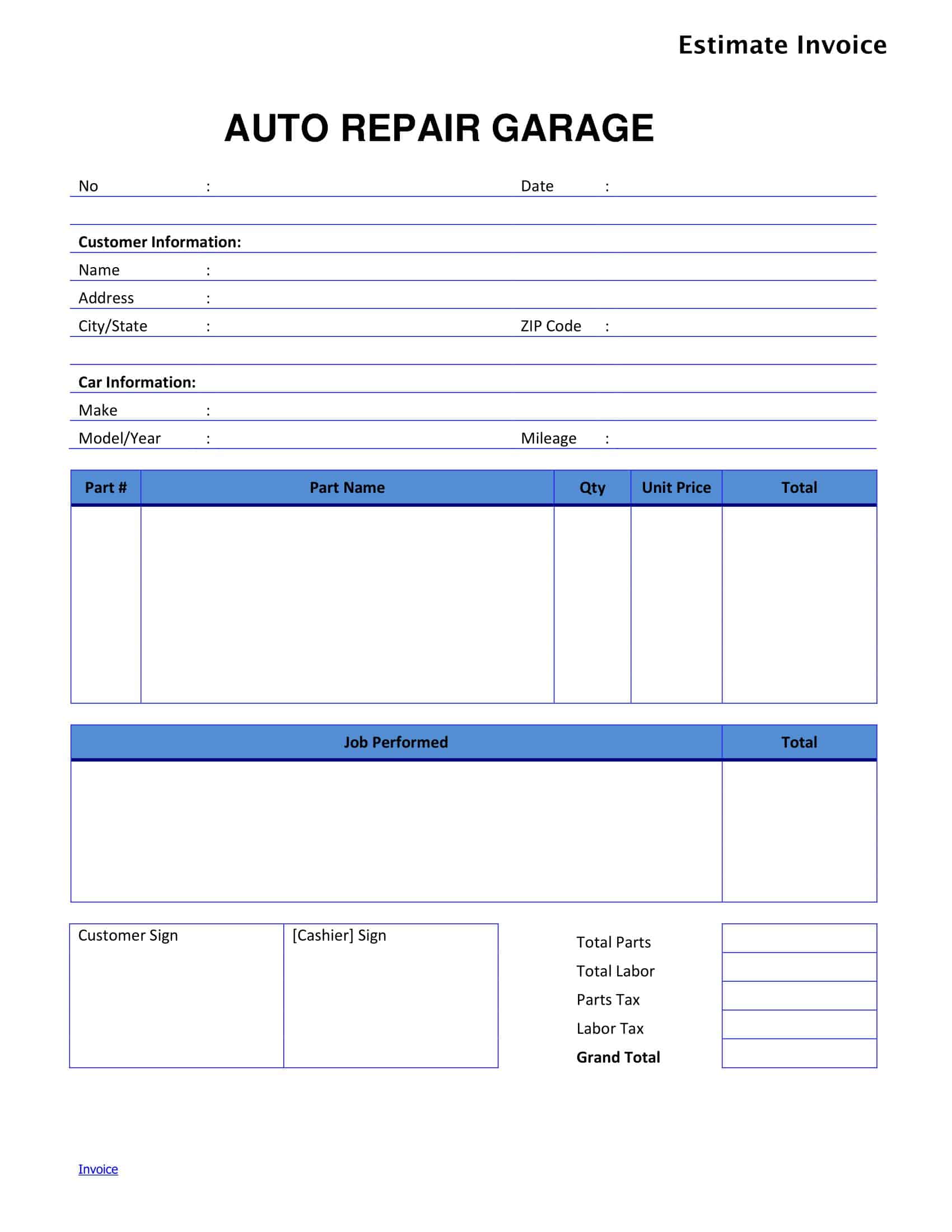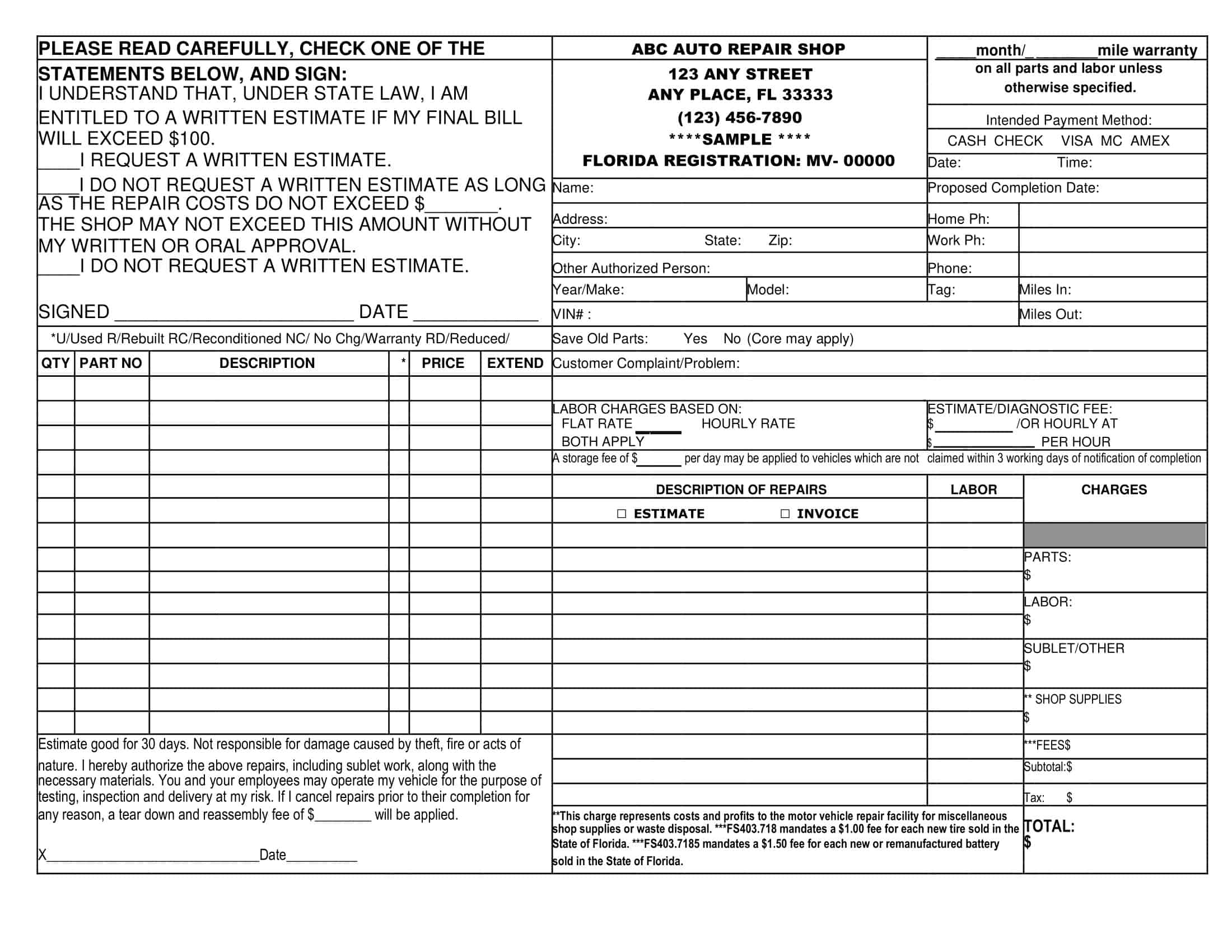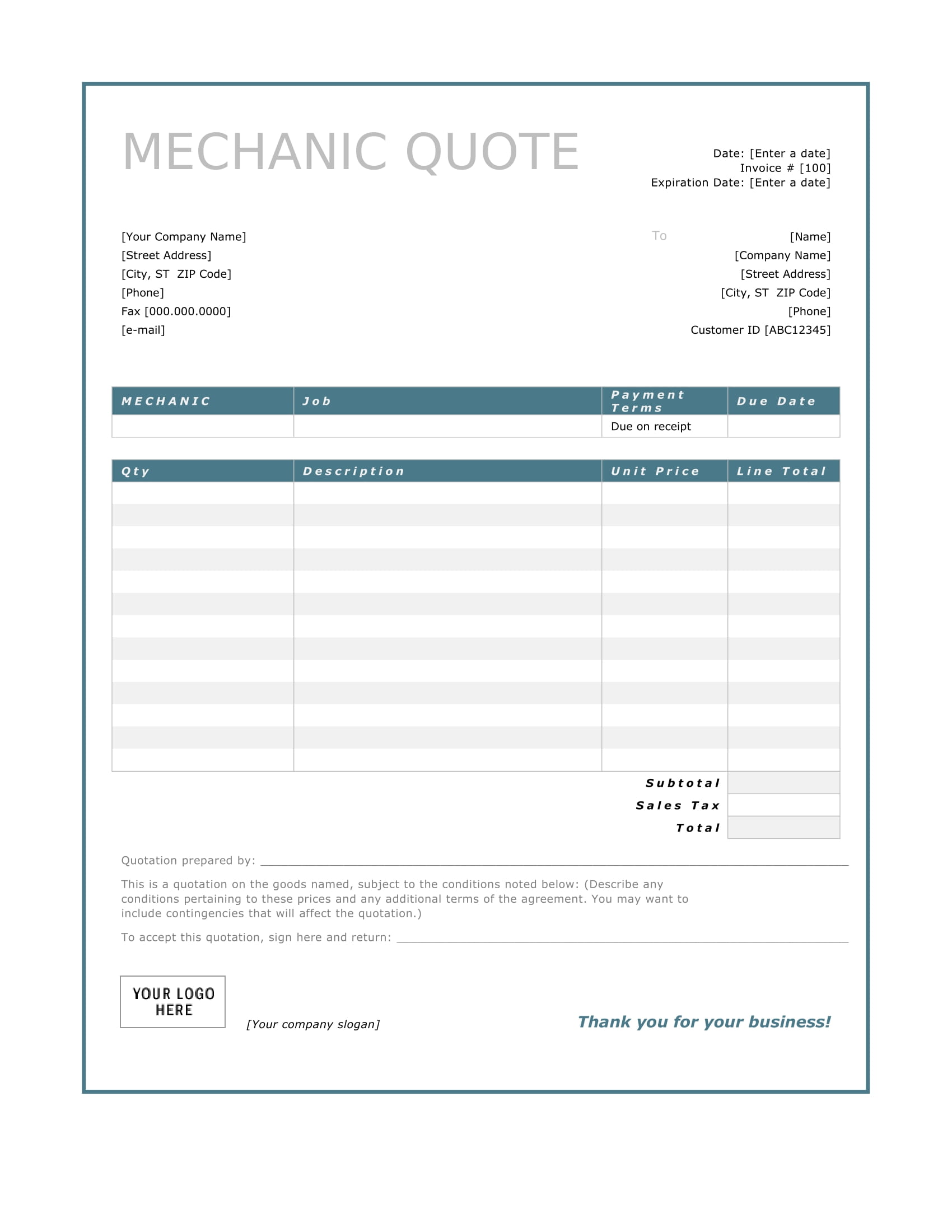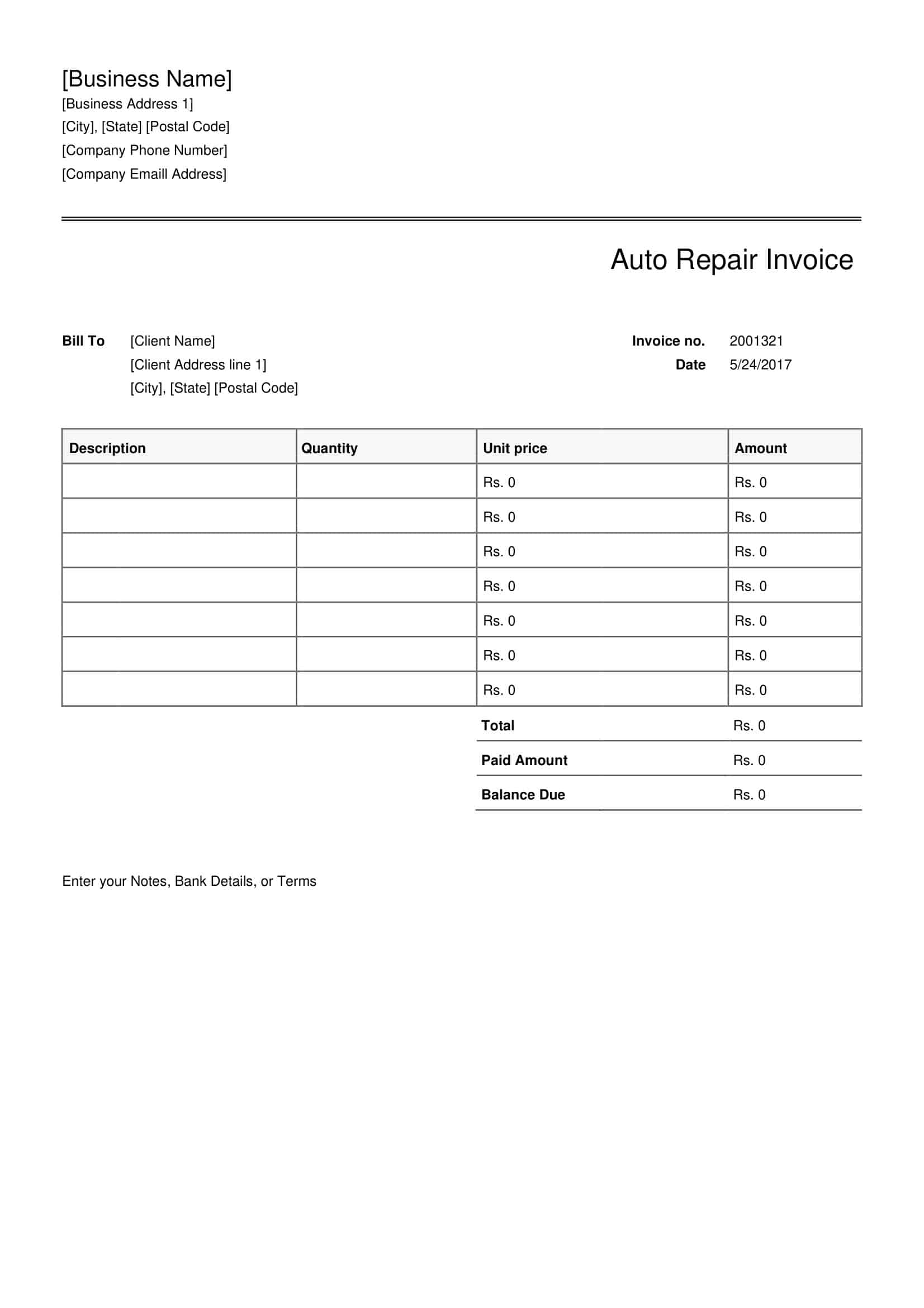As every vehicle takes to the road, it’s inevitably subject to wear and tear. Whether a simple oil change or a complex engine overhaul, these mechanical procedures are part and parcel of car ownership. But what links the vehicle owner, the mechanic, and the work done is a crucial piece of paper: the auto repair invoice.
This article illuminates the structure, importance, and nuances of an auto repair invoice, providing a comprehensive guide to understanding its elements and their relevance in the auto repair industry. So buckle up as we shift gears to drive you through the ins and outs of this essential document.
Table of Contents
What is an Auto Repair Invoice?

An auto repair invoice is a detailed document provided by mechanics or auto repair shops to customers upon the completion of work on a vehicle. It outlines the services performed, parts replaced, labor hours spent, and their corresponding costs.
This crucial document often includes other information such as the vehicle’s details, customer’s contact information, the repair shop’s particulars, invoice number, and date of service. By creating a clear, understandable, and transparent breakdown of charges, an auto repair invoice not only facilitates smooth transactions but also promotes trust between the repair service provider and the client.
Auto Repair Invoice Templates
An Auto Repair Invoice Template is a crucial business document used by auto repair shops or independent auto repair professionals. It outlines services rendered, parts replaced or used, and the associated costs, helping to maintain transparent and professional dealings with clients.
Usually found at the top of the template is the business information section. This part includes the name, address, and contact information of the repair shop or mechanic. It also contains the client’s details like name, contact information, and vehicle details.
Next, one often finds the invoice number and date of issue fields. These are crucial for record-keeping, tracking services, and managing payments. A unique invoice number is generated for every transaction, aiding in preventing mix-ups and easing tracking.
Benefits of using an auto repair invoice template
Utilizing an auto repair invoice template offers numerous advantages that streamline business operations, boost professionalism, and enhance customer satisfaction. Here’s a detailed guide highlighting these benefits:
Standardization and Consistency: An invoice template allows for uniformity in documentation. Every invoice issued follows the same format, making it easier for staff and clients to locate and understand information. This consistency also fosters a professional image for your auto repair business.
Time-Efficiency: A template reduces the time spent on invoice creation. With a pre-established format, the mechanic or admin staff just need to fill in the specific details for each job, saving time that can be used to focus on the core business operations.
Error Minimization: With clear sections and fields to fill in, an auto repair invoice template helps minimize mistakes. It ensures all necessary information is captured accurately, reducing potential billing disputes with clients.
Record Keeping: These templates provide a systematic way to keep track of financial transactions, parts used, and services provided. They can easily be stored and retrieved for future reference, making them invaluable for accounting purposes, inventory management, and business analysis.
Branding: A customized invoice template can incorporate your business logo, tagline, and color scheme, which aids in promoting and reinforcing your brand identity to customers.
Legal Protection: A detailed invoice serves as a legal document that can protect your business in case of disagreements or litigation. It provides proof of what work was done, the costs involved, and the agreement between your business and the client.
Transparency and Trust: By offering a detailed breakdown of the cost for parts and labor, an auto repair invoice template ensures transparency. This can help build trust with your clients, leading to better customer relationships and potential repeat business.
What to Include in Your Auto Repair Invoice
Creating an effective auto repair invoice requires meticulous attention to detail to ensure that all necessary information is included. Here is a comprehensive guide on the elements that should be incorporated into your auto repair invoice:
Business Information: The invoice should clearly state the name, address, phone number, email, and other relevant contact details of your auto repair shop. It may also include your business logo for branding purposes.
Customer Information: The client’s full name, contact number, address, and email should be indicated. This ensures clear communication channels between the business and the customer.
Vehicle Information: Include crucial details about the vehicle such as the make, model, year, color, VIN (Vehicle Identification Number), and the mileage at the time of repair.
Invoice Number: Each invoice should have a unique number for easy reference and tracking. This can be particularly useful for customer inquiries, warranty claims, or accounting purposes.
Date: The date when the service was rendered or completed should be clearly specified.
List of Services and Parts: Provide a detailed breakdown of all the services performed and parts replaced. Each service or part should be listed individually, along with a brief description if necessary.
Labor and Cost: For each service or part listed, include the labor hours spent and their corresponding costs. Make sure to distinguish between the cost of parts and the cost of labor.
Total Cost: Summarize the total cost of the services, including parts and labor. If any taxes are applicable, they should be included in this section.
Payment Terms: Indicate the acceptable methods of payment (cash, check, credit card, etc.), and if there are any payment terms like due dates or late payment penalties.
Warranty Information: If any warranty is associated with the services provided or parts replaced, the details should be mentioned, including the scope and duration of the warranty.
Signatures: Some businesses opt to include a space for the customer’s signature, acknowledging the work done and costs involved.
Notes or Disclaimers: Any extra information that needs to be communicated to the client, or disclaimers related to the service, can be included in this section.
Estimate vs. Invoice: Demystifying Auto Repair Quotations
In the auto repair industry, two types of documents often come into play: estimates and invoices. Despite their shared importance, each serves a unique purpose and contains specific information. Understanding their roles and differences is essential for both service providers and customers.
Estimates in Auto Repair
An estimate, as the name suggests, is a professional guess or approximation of what a specific repair job is expected to cost. It’s provided before any work commences and breaks down the probable cost of parts and labor. Key aspects include:
- Purpose: The main objective of an estimate is to give the vehicle owner an idea of the likely cost. This allows the customer to budget, make informed decisions, and compare prices if needed.
- Content: An estimate includes a list of the predicted services and parts needed for the repair, with an approximate cost for each.
- Flexibility: Estimates are not set in stone. The final cost may vary due to unforeseen issues that arise once work begins, changes in the price of parts, or additional labor time required.
- Legal Aspect: In many regions, mechanics are required to provide an estimate and must seek the customer’s approval before exceeding the estimated costs by a certain percentage.
Invoices in Auto Repair
On the other hand, an invoice is a bill presented to the customer after the repair work is complete. It details the actual services rendered, parts replaced, labor time, and their respective costs. Here’s more about invoices:
- Purpose: The invoice serves as a request for payment, showing the client what they’re being charged for and the total amount due. It also acts as a legal document that can be used in disputes and for accounting records.
- Content: An invoice includes the definitive list of services performed and parts used, along with their individual costs. It also carries other information such as business details, customer details, vehicle details, invoice number, and date.
- Finality: Unlike an estimate, an invoice reflects the final and actual costs of the repair work. Any deviation from the initial estimate should have been communicated and approved before the completion of the work.
- Legal Aspect: An invoice serves as proof of the agreement between the repair shop and the customer. It’s a binding document that can be used in case of legal disputes and is crucial for tax purposes.
How to Create an Auto Repair Invoice
Creating an auto repair invoice involves several steps, each requiring attention to detail to ensure accuracy and completeness. Here’s a step-by-step guide to help you craft a professional and comprehensive auto repair invoice:
Step 1: Select a Template
Start by choosing an invoice template that suits your business. Many software programs offer customizable invoice templates, or you can create your own using a program like Microsoft Word or Excel.
Step 2: Insert Business Details
Add your business information at the top of the invoice. This should include your business name, address, contact number, email, and logo if you have one.
Step 3: Add Customer Information
Input the customer’s details, such as their name, address, contact number, and email. This will ensure clear lines of communication and can help if there are any follow-up actions or disputes.
Step 4: Detail the Vehicle Information
Include specific information about the customer’s vehicle, including the make, model, year, color, VIN (Vehicle Identification Number), and mileage at the time of service.
Step 5: Assign an Invoice Number and Date
Each invoice should have a unique number for easy tracking and referencing. Also, include the date when the service was rendered.
Step 6: List Services and Parts
Provide a detailed breakdown of all the services performed and parts replaced. Each item should be listed individually along with a brief description if necessary.
Step 7: Specify Labor and Cost
Next to each listed service or part, indicate the labor hours required and the corresponding costs. Be sure to distinguish between the cost of parts and labor.
Step 8: Calculate the Total Cost
Add up all the costs to provide a grand total. If any taxes apply, they should be calculated and included in this section.
Step 9: Mention Payment Terms
Indicate the acceptable forms of payment (cash, check, credit card, etc.), and if there are any specific payment terms or deadlines.
Step 10: Include Warranty Information
If you provide a warranty on any parts or services, include the details of this, outlining the scope and duration of the warranty.
Step 11: Space for Signature
Consider including a space for the customer’s signature to acknowledge the receipt of services and the understanding of costs.
Step 12: Add Notes or Disclaimers
If there’s any additional information or disclaimers related to the service, these can be included at the bottom of the invoice.
Conclusion
In conclusion, the auto repair invoice serves as more than just a payment request after services rendered. It is a vital tool that streamlines business operations, boosts professionalism, enhances customer relationships, and provides a record for legal and accounting purposes. By detailing the services provided, parts replaced, labor costs, and other relevant information, it facilitates transparency and fosters trust between the auto repair shop and the customer. Understanding its components, benefits, and the process of creation is fundamental to effectively navigate the auto repair industry, whether as a service provider or a customer. Ultimately, a well-structured auto repair invoice stands as a testament to a repair shop’s integrity, professionalism, and commitment to customer satisfaction.
FAQs
Are there any legal requirements for an Auto Repair Invoice?
Legal requirements for an Auto Repair Invoice can vary depending on the jurisdiction. It’s important to comply with local laws and regulations regarding invoicing, tax obligations, and disclosure requirements. In some regions, specific information, such as the auto repair shop’s license number or certifications, may need to be included on the invoice. It’s advisable to consult with a legal professional or accountant familiar with your local regulations to ensure compliance.
Can I use electronic Auto Repair Invoices?
Yes, electronic Auto Repair Invoices are commonly used today. Many auto repair shops utilize computer software, online invoicing platforms, or specialized accounting tools to create and send electronic invoices to their customers. Electronic invoices offer advantages such as speed, convenience, and easier record-keeping. However, it’s essential to ensure that electronic invoices comply with legal requirements in your jurisdiction, such as electronic signature laws and data privacy regulations.
Can I modify an Auto Repair Invoice template to suit my specific needs?
Yes, you can modify an Auto Repair Invoice template to suit your specific needs. Templates are usually designed to be customizable, allowing you to add or remove fields, adjust the layout, change colors and fonts, and incorporate your own branding elements. Depending on the software or platform used to create the template, customization options may vary, so it’s important to choose a template that offers the flexibility you require.
Are there any software or tools specifically designed for Auto Repair Invoicing?
Yes, there are software and tools specifically designed for auto repair invoicing. These tools often include features tailored to the needs of auto repair shops, such as inventory management, labor tracking, service descriptions, and integration with accounting systems. Some popular auto repair invoicing software options include RepairShopr, Shop-Ware, AutoRepair Cloud, and GaragePlug. It’s important to evaluate different options based on your specific requirements and budget to find the best fit for your auto repair business.
How long should I retain Auto Repair Invoices?
The duration for retaining Auto Repair Invoices may vary based on legal requirements and business needs. In general, it is advisable to retain invoices for a minimum of three to seven years. This duration ensures compliance with tax regulations and allows for reference in case of disputes, warranty claims, or audits. However, specific retention periods can vary by jurisdiction, so it’s important to consult with a legal professional or accountant familiar with the regulations in your area.




































![Free Printable Roommate Agreement Templates [Word, PDF] 1 Roommate Agreement](https://www.typecalendar.com/wp-content/uploads/2023/06/Roommate-Agreement-150x150.jpg)
![Free Printable Credit Card Authorization Form Templates [PDF, Word, Excel] 2 Credit Card Authorization Form](https://www.typecalendar.com/wp-content/uploads/2023/06/Credit-Card-Authorization-Form-150x150.jpg)
![Free Printable Stock Ledger Templates [Excel,PDF, Word] 3 Stock Ledger](https://www.typecalendar.com/wp-content/uploads/2023/08/Stock-Ledger-150x150.jpg)
